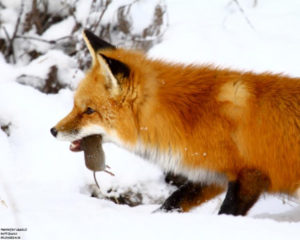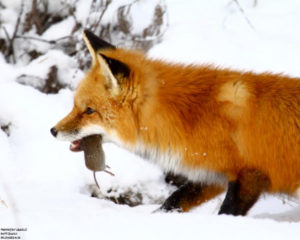

red fox on the hunt
As soon as I stepped out of the car, the sound sent a chill down my spine. It came from over on the hillside, but in the black of a night, I couldn’t see anything. At first, I thought it to be a child screaming, or a woman in pain.
As I pondered the source of this noise, the shrill shriek pierced the darkness again from the same place. It didn’t sound human — a sort of shriek and scream that lasted about two seconds. Five times within a minute, the strange call pierced the night.
Could it be some sort of bird, perhaps an owl?
After coming home, my curiosity got the best of me, as I searched the Internet for more information, googling “animals that scream during the night”. I cross referenced that with wildlife living in this part of Colorado, narrowing it down and listening to the audio clips of owls, bobcats, and red foxes.
After consulting with my husband, we finally decided that it was indeed a red fox. Red foxes frequently scream at night, with the screams occurring in sets of five or more separated by a few seconds.
Why do they scream? Frequently as a warning sign when they sense a predator is near — a coyote, or mountain lion. Red foxes also scream when mating, much like wild cats.
One night shortly after Bryon and I moved into our Nederland home, we were awakened by a piercing wail that lasted for 10-15 seconds, one right after another. It sounded like a woman in labor, with a high-pitched wail. This kept on for 10 or 15 minutes, and with the windows open, it was impossible for us to get back to sleep. What on earth was it?
After more research, and given the length of this terrible screaming, we decided it came from two bobcats mating. Just earlier in the week, we had spotted a bobcat on our front porch. Seeing the furry animal through the window, I first thought it to be the neighbor’s cat. But the red, tawny fur with spots and the lack of tail gave it away. Days later we heard the shrieking episode.
While we sometimes see our wildlife neighbors, many of the wildlife we share our habitat with is most active at night, or nocturnal. They depend on the dark of night to hunt their prey and provide much needed food. Often the only sign of their having been nearby is not by sight, but by sound.
As a Park Ranger, I frequently was asked about the best way to see wildlife, to which I replied “take a night prowl hike!” Getting outside at night or taking a drive on a country road late at night, you might be surprised by how much you see, or what you hear.

